Related Research Articles

Green tea is a type of tea that is made from Camellia sinensis leaves and buds that have not undergone the same withering and oxidation process used to make oolong teas and black teas. Green tea originated in China, and since then its production and manufacture has spread to other countries in East Asia.

Barley tea is a roasted-grain-based infusion made from barley. It is a staple across many East Asian countries such as China, Japan, Korea and Taiwan. It has a toasty, bitter flavor.

Compressed tea, called tea bricks, tea cakes or tea lumps, and tea nuggets according to the shape and size, are blocks of whole or finely ground black tea, green tea, or post-fermented tea leaves that have been packed in molds and pressed into block form. This was the most commonly produced and used form of tea in ancient China prior to the Ming Dynasty. Although tea bricks are less commonly produced in modern times, many post-fermented teas, such as pu-erh, are still commonly found in bricks, discs, and other pressed forms. Tea bricks can be made into beverages like tea or eaten as food, and were also used in the past as a form of currency.

Yuja-cha or yuja tea is a traditional Korean tea made by mixing hot water with yuja-cheong. Yuja tea is popular throughout Korea, especially in the winter. This tea is created by curing yuja into a sweet, thick, pulpy syrup. It does not contain caffeine. It is often sold in markets in large jars and used as a home remedy for the common cold.

Oksusu-cha (옥수수차) or corn tea is a Korean tea made from corn. While oksusu-suyeom-cha (옥수수수염차) or corn silk tea refers to the tea made from corn silk, oksusu-cha can be made from corn kernels, corn silk, or a combination of both. The caffeine-free infusion is a popular hot drink in winter. Along with bori-cha, oksusu-cha is one of the free grain teas served in many restaurants in place of water.
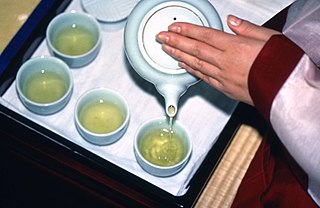
Korean tea is a beverage consisting of boiled water infused with leaves, roots, flowers, fruits, grains, edible mushrooms, or seaweed. It may or may not contain tea leaves.

Fermented tea is a class of tea that has undergone microbial fermentation, from several months to many years. The exposure of the tea leaves to humidity and oxygen during the process also causes endo-oxidation and exo-oxidation. The tea leaves and the liquor made from them become darker with oxidation. Thus, the various kinds of fermented teas produced across China are also referred to as dark tea, not be confused with black tea. The most famous fermented tea is pu'er produced in Yunnan province.

Tea processing is the method in which the leaves from the tea plant Camellia sinensis are transformed into the dried leaves for brewing tea.

Arrowroot tea, also called kudzu tea, is a traditional East Asian tea made from East Asian arrowroot, a type of kudzu.

Lotus tea is an infusion made from lotus leaves, flowers, roots, fruit, seeds, or embryos. It is known as liánchá in Chinese and yeoncha in Korean. It is also known as trà sen in Vietnamese.

Matcha is finely ground powder of specially grown and processed green tea leaves, traditionally consumed in East Asia. The green tea plants used for matcha are shade-grown for three to four weeks before harvest; the stems and veins are removed during processing. During shaded growth, the plant Camellia sinensis produces more theanine and caffeine. The powdered form of matcha is consumed differently from tea leaves or tea bags, as it is suspended in a liquid, typically water or milk.

Pine needle tea or pine leaf tea is a herbal tea made from pine needles, or the leaves of pine trees. In Korea, the tea made from the leaves of Korean red pine or Manchurian red pine is known as solip-cha (솔잎차), while the tea made from the leaves of Korean pine is known as jannip-cha (잣잎차) or baek yeop-Cha. In North America, pine needle tea may be made from the leaves of Eastern white pine and Loblolly, Virginia Pine, Long Leaf Pine.
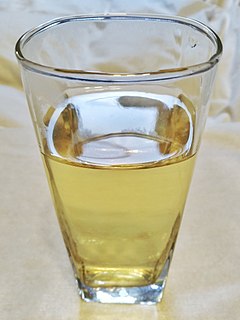
Brown rice green tea is green tea blended with roasted brown rice. In Korea, it is called hyeonmi-nokcha and is considered a blend of nokcha and hyeonmi-cha. In Japan, green tea blended with puffed brown rice is called genmaicha.
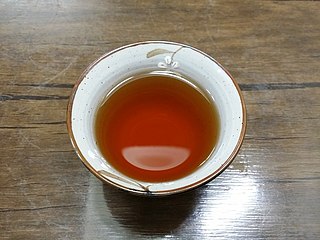
Gyeolmyeongja-cha or sicklepod tea is a tea made from roasted seeds of Senna spp., especially S. obtusifolia and S. tora.

Buckwheat tea, known as memil-cha (메밀차) in Korea, soba-cha (そば茶) in Japan, and kuqiao-cha (苦荞茶) in China, is a tea made from roasted buckwheat. Like other traditional Korean teas, memil-cha can be drunk either warm or cold and is sometimes served in place of water. Recently, tartari buckwheat grown in Gangwon Province is popular for making memil-cha, as it is nuttier and contains more rutin.

Maesil-cha or plum tea is a traditional Korean tea made from maesil, omae, or maesil-cheong.
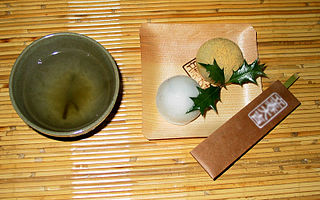
Kelp tea is a traditional East Asian tea made by infusing kelp in hot water. It is called kobu-cha or konbu-cha (昆布茶) in Japan, haidai-cha (海带茶) in China and dasima-cha (다시마차) in Korea.

Sunset in My Hometown is a 2018 South Korean drama film and the thirteenth feature film directed by Lee Joon-ik. The film stars Park Jeong-min and Kim Go-eun.
Kuk Young is a South Korean physicist, former physics professor and vice-provost of research of Seoul National University, distinguished professor of Ewha Womans University, and chairman of the Samsung Science and Technology Foundation. He is a fellow of the American Physical Society, Korean Academy of Science and Technology, Institute of Physics, Korean Physical Society, and Korean Vacuum Society. He has performed editor roles for the journals Nanotechnology, ACS Nano, and Solid State Electronics and is the fourth president of Daegu Gyeongbuk Institute of Science and Technology (DGIST).
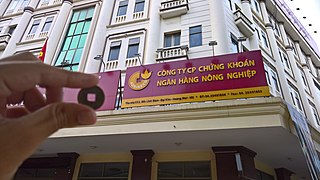
Cash coins are a type of historical Chinese, Japanese, Korean, Ryukyuan, and Vietnamese coin design that was the main basic design for the Chinese cash, Japanese mon, Korean mun, Ryukyuan mon, and Vietnamese văn currencies. The cash coin became the main standard currency of China in 221 BC with the Ban Liang (半兩) and would be produced until 1912 AD there with the Minguo Tongbao (民國通寶), the last series of cash coins produced in the world were the French Indochinese Bảo Đại Thông Bảo (保大通寶) during the 1940s. Cash coins are round coins with a square centre hole. It is commonly believed that the early round coins of the Warring States period resembled the ancient jade circles (璧環) which symbolised the supposed round shape of the sky, while the centre hole in this analogy is said to represent the planet earth (天圓地方). The body of these early round coins was called their "flesh" (肉) and the central hole was known as "the good" (好).
References
- ↑ Whitburn, Joel (2004). The Billboard Book Of Top 40 Country Hits: 1944-2006, Second edition. Record Research. p. 313.
- ↑ "T.G. Sheppard Chart History (Hot Country Songs)". Billboard.